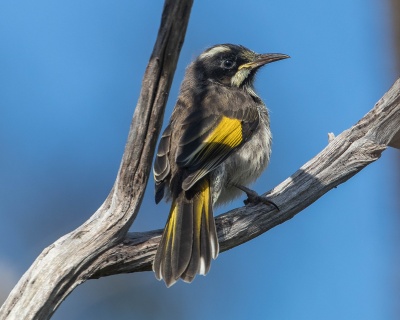- Phylidonyris novaehollandiae
Identification
Black and white, large yellow wing patch, yellow sides on the tail, small white ear patch, a thin white whisker at the base of the bill and a white eye.
Sexes are similar, females slightly smaller.
Young birds are browner and have a grey eye.
Similar Species
White-cheeked Honeyeater see image by Peter Day for comparison.
Click on image for larger version
Showing White-cheeked Honeyeater for comparison
Photo © by Peter Day
Cox Scrub Conservation Park South Australia, October 2022
Distribution
Australia: found in south east Queensland to Victoria, South Australia. South West Western Australia'
Taxonomy
Subspecies
There are 5 subspecies[1]:
- P. n. novaehollandiae:
- South East Queensland to Victoria and Eyre Peninsula (South Australia)
- P. n. caudatus:
- King Island and Flinders Islands (Bass Strait)
- P. n. canescens:
- Tasmania
- P. n. campbelli:
- Kangaroo Island (South Australia)
- P. n. longirostris:
- South West Western Australia
Habitat
Low scrub, swamps, heath, woodlands particularly where banksias are common.
Behaviour
Diet
They eat mainly nectar but also fruit, insects and spiders.
Breeding
The cup-shaped nest is made of bark and grasses, bound together with spider web, lined with soft material and is placed in a bush or tree. Both sexes feed the chicks. A pair of adults may raise two or three broods in a year.
References
- Clements, J. F., T. S. Schulenberg, M. J. Iliff, T. A. Fredericks, J. A. Gerbracht, D. Lepage, S. M. Billerman, B. L. Sullivan, and C. L. Wood. 2022. The eBird/Clements checklist of Birds of the World: v2022. Downloaded from https://www.birds.cornell.edu/clementschecklist/download/
Recommended Citation
- BirdForum Opus contributors. (2024) New Holland Honeyeater. In: BirdForum, the forum for wild birds and birding. Retrieved 27 April 2024 from https://www.birdforum.net/opus/New_Holland_Honeyeater
External Links
GSearch checked for 2020 platform.1






